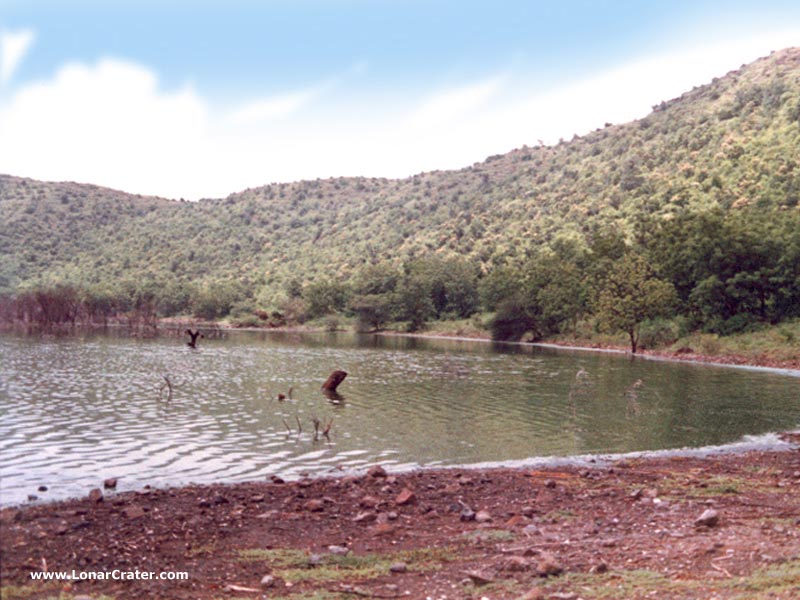Lonar by Sahyadri Explorers
Lonar Lake
This world famous lake was formed 50,000 years ago when a meteor struck this part of Earth. It ranks third among five largest craters on the earth and is the only meteoric crater in basaltic region.
According to scientists, about 50000 years ago a massive meteor entered into the Earth's gravitational forces range. 60 meter long and weighing 20 lac ton it was racing at a speed of 25 kms per second towards the blue planet. When it struck the earth the energy released was equivalent to that released by six-megaton atom bombs! The impact was so severe that rocks from all sides came to the surface and reached the height of 20 meters. So strong was the impact that it left a massive crater 170 meter deep and with 1800 meter in diameter.
Today it is one of the biggest natural salt-water lake in India.

Alongside of the lake are numerous temples dating back to 11th century. One such famous temple is Daityasoodan Temple built in Hemadpanthi style of Architecture. Also nearby is a fresh water stream, which is not salty. But water in the lake is highly salty unsuitabl to sustain normal ecology in it. The ecology developed in the lake is therefore completely different and is a matter of interest & research in scientific community.

Temples located inside the crater.
RamgayaIt is said that Lord Rama visited this place, hence the curious name given to the temple. This group of temples has three elements, namely a. Lord Ram�s temple, b. Lord Shiva�s temple, c. a pond known as �Barav�. Besides a wooden statue of Rama, there are some recesses in the interior containing statues of secondary Gods. There are three entrances and on one of the door frames the word Vasuji is carved, he was probably the head mason of this temple.
A small structure of Hanuman lies in the front of the main entrance. Lord Shiva�s temple has three elements of a typical Indian temple, namely, garbh-griha, antrala and mandapa. A unique Sivalinga is placed here. Nandi-shrine is not placed on the east-side as in a typical Shiva temple. The �Barav� also known as Rama Kunda Barav is a rectangular pond which had a natural water source but, due to some reasons, the direction of water has changed. This pond was used for ablutions before entering the temple. Regarding the orientation, as stated before, most of the temples face towards the lake, so this temple also, unlike a typical Indian temple, does not face the east but is oriented westwards
Vishnumandir
The Vishnu temple is located near the lake. The construction is similar to the Ramgaya temple. Some of the stones and pillars are well be preserved. It is believed that Rama had visited this place and performed �Tarpan� (a ritual held for the dead) of his father Dashratha. The temple hosts a Shiva and a Ganesha Idol. The entrance of the inner chamber has beautiful carvings of lions.
Wagh Mahadeva
Further along the the way from the Ramgaya temple is this east-facing temple. You can enter this bat infested temple from the north side. You will find a carved pillar depicting a fight between a lion and an elephant. This was the insignia of the Hoysala kings which suggests that the Hoysala kings contributed to the erection of this temple. As one steps out of the door on the left, one sees another pillar with an outstanding sculpture of a Naga princess (naga kanya).
Mora Mahadeva/Munglyacha Mandir (the temple of ants)
The outer sides of this temple are extremely crude. It contains neither a Sivalinga nor a Shiva idol. The sculpture of the Naga princess is exquisite.
Goddess Kamalaja Devi
The most important and most frequented of the temples on the crater rim, this temple faces south. This was the meditation place of Chakradhar Swami. References are found which state that he did penance in the Bhairav temple next to the Kamalaja Devi temple. Due to the constant flow of devotees, specially during the Navratri festival this temple is fairly well preserved and painted at regular intervals. The deepa mala or the pillar of lamps has a heart shaped or peepul leaf shaped yoni kunda at its base. Instead of an idol of the Goddess, there is a tandala. Several temples are located here including the Devi temple, a large structure with a stone plinth that stands amongst the trees at the edge of the lake. Along the rim of the crater is present the Gomukh Temple, which is where the perennial stream emerges and pilgrims visiting the temple, bathe in the stream.
FAQs |
Location : Buldhana District Area : 1.8 Km (Diameter); 132 m (deep) Flora & Fauna : The animals and birds visible here are migratory Flamingoes, Indian Moorhen, Coot, Dabchick, Langoors, Chinkaras, Peacocks and Gazelles. |